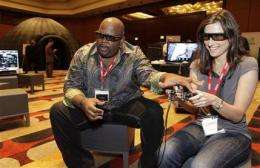Sony senior producer Travis Williams, left, trains Jen Steele, right, to play on a 3D console on a Sony Playstation 3 at the 3D Gaming Summit held at the Universal City in Los Angeles on Thursday, April 22, 2010. (AP Photo/Damian Dovarganes)
(AP) -- For movie goers, watching a 3-D film is a relatively easy experience. Audiences didn't need to do anything other than pay a few extra bucks and slip on a pair of special glasses to see 3-D versions of "Avatar" or "Alice in Wonderland." For gamers, however, enjoying a 3-D game requires a bigger investment on their part.
For example, to play the popular online fantasy game "World of Warcraft" in 3-D, an inhabitant of Azeroth would need hundreds of dollars worth of gear: a robust computer setup with a compatible graphics card, monitor capable of displaying 3-D and a pair of 3-D spectacles. At this early stage, it's an expense that many virtual adventurers have yet to adopt.
Dozens of game developers, business executives and other stereoscopic 3-D gaming advocates converged at a Universal City hotel this week to explore that very conundrum and witness the latest in 3-D games at the first-ever 3-D Gaming Summit. The consensus was that whether gamers push play on 3-D or not, the home 3-D revolution is already in motion.
Television makers Samsung and Panasonic are now selling 3-D TVs. Movie studios Universal and Disney have released 3-D films on Blu-ray, such as "Coraline" and "The Polar Express." Discovery Communications and ESPN previously announced they will launch their own 3-D networks, with ESPN first broadcasting FIFA World Cup soccer in 3-D this June.
"We've got to tell people about it," said Phil Eisler, general manager of Nvidia's 3-D Vision, which makes graphics cards with 3-D processing power. "Hollywood has done a fantastic job of educating consumers and marketing to them about the wonderful experience in the theater. We need to tell consumers about the wonderful experience that games are in 3-D."
For many modern games, the leap to 3-D is actually just a step. The medium is well suited for 3-D because the majority of today's games are created in three dimensions, making conversion a snap. Eisler said more than 400 current PC games, including "Battlefield: Bad Company 2" and "Resident Evil 5," can be played in 3-D with the right equipment.
"You're seeing it now," said "Avatar" producer Jon Landau. "People are going to want 3-D in their homes. I think 3-D is going to become ubiquitous in everything we do. From what I understand of the initial TV sales at Best Buy, everything went out the door. Why? Because it's of a certain quality, and I think that's what we have to make sure we protect."
The biggest hurdle for 3-D gaming is perhaps the simplest: Those glasses are just plain annoying. Michael Cai, a video game analyst at research firm Interpret, found in a recent survey of players who had experienced 3-D games that having to don shades was the overwhelming aversion to the medium. However, many had no qualms about 3-D gaming at all.
Sony and Nintendo have already unveiled their initial plans to enter the 3-D realm. Sony began updating PlayStation 3 consoles this week for future 3-D gaming features, which are expected this summer. Last month, Nintendo revealed a 3-D version of its top-selling handheld DS system - called 3DS - that wouldn't require 3-D glasses due out later this year.
"One of the big advantages of the gaming market is that it's extremely viral," said Neil Schneider, president of 3-D gaming advocacy group Meant to be Seen. "If there's a way to capture the interest of just a handful of these gamers, it's the consumers that could help drive this industry forward, perhaps more influential than a retail display at Best Buy."
More information: http://www.3dgamingsummit.com/
©2010 The Associated Press. All rights reserved. This material may not be published, broadcast, rewritten or redistributed.



















